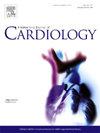Gut dysbiosis and neutrophil extracellular traps in chronic heart failure
IF 3.2
2区 医学
Q2 CARDIAC & CARDIOVASCULAR SYSTEMS
引用次数: 0
Abstract
Background
Chronic heart failure (HF) patients have reduced microbiota diversity. Leakage of microbes and their metabolites into the bloodstream may activate neutrophils. Neutrophil extracellular traps (NETs) consist of chromatin and proteases, and may contribute to HF pathogenesis. We assessed associations between circulating NETs and 1) cardiac function, 2) the degree of gut microbiota diversity and 3) gut leakage and microbial metabolites in HF patients.
Methods
A cross-sectional study including 124 patients with chronic HF and left ventricular ejection fraction ≤40 %. Severe HF was defined as N-terminal pro-B-type natriuretic peptide concentrations above median. We measured citrullinated histone H3 (CitH3), myeloperoxidase- and double-stranded-DNA in the blood. Gut leakage markers included bacterial lipopolysaccharides and soluble cluster of differentiation 14. The microbial metabolites included circulating trimethylamine N-oxide and butyrate producing capacity. We used the Shannon diversity-index and a dysbiosis-index based on bacteria with altered relative abundance to characterize the gut microbiota profile.
Results
Quartile 4 of CitH3 was associated with more severe HF compared to quartiles 1–3, after adjustments for age, gender and hypertension (adjusted odds ratio [95 %CI] 3.21[1.18–8.69], p = 0.022). CitH3 was moderately associated with hypertension (p = 0.04), higher CRP levels (p = 0.016) and lower Shannon diversity index, (p = 0.039). No other NET marker associated with severe HF.
Conclusions
In chronic HF patients with reduced LVEF, high levels of CitH3 were associated with disease severity, inflammation and reduced gut microbiota diversity. Our results suggest that enhanced release of NETs could be involved in progressive HF, although the contribution of the gut microbiota seems limited in this context.

慢性心力衰竭中的肠道菌群失调和中性粒细胞胞外捕获器
背景:慢性心力衰竭(HF)患者的微生物群多样性降低。微生物及其代谢产物渗入血液可激活中性粒细胞。中性粒细胞胞外捕获物(NET)由染色质和蛋白酶组成,可能有助于心力衰竭的发病。我们评估了循环中性粒细胞捕获物与下列因素之间的关系:1)心脏功能;2)肠道微生物群多样性程度;3)高血压患者的肠道渗漏和微生物代谢物:横断面研究:包括 124 名左心室射血分数低于 40% 的慢性高血压患者。N末端前B型钠尿肽浓度超过中位数即定义为重度心房颤动。我们测量了血液中的瓜氨酸组蛋白 H3(CitH3)、髓过氧化物酶和双链 DNA。肠道渗漏标记物包括细菌脂多糖和可溶性分化簇 14。微生物代谢物包括循环中的三甲胺 N-氧化物和丁酸盐生产能力。我们使用香农多样性指数和基于相对丰度改变的细菌的菌群失调指数来描述肠道微生物群谱:结果:在对年龄、性别和高血压进行调整后,与 1-3 四分位数相比,CitH3 四分位数与更严重的高血压相关(调整后的几率比 [95 %CI] 3.21[1.18-8.69], p = 0.022)。CitH3与高血压(p = 0.04)、较高的CRP水平(p = 0.016)和较低的香农多样性指数(p = 0.039)呈中度相关。没有其他NET标记物与重度HF相关:结论:在 LVEF 降低的慢性 HF 患者中,高水平的 CitH3 与疾病严重程度、炎症和肠道微生物群多样性降低有关。我们的研究结果表明,虽然肠道微生物群的作用似乎有限,但NET的释放增强可能与进展性高血压有关。
本文章由计算机程序翻译,如有差异,请以英文原文为准。
求助全文
约1分钟内获得全文
求助全文
来源期刊

International journal of cardiology
医学-心血管系统
CiteScore
6.80
自引率
5.70%
发文量
758
审稿时长
44 days
期刊介绍:
The International Journal of Cardiology is devoted to cardiology in the broadest sense. Both basic research and clinical papers can be submitted. The journal serves the interest of both practicing clinicians and researchers.
In addition to original papers, we are launching a range of new manuscript types, including Consensus and Position Papers, Systematic Reviews, Meta-analyses, and Short communications. Case reports are no longer acceptable. Controversial techniques, issues on health policy and social medicine are discussed and serve as useful tools for encouraging debate.
 求助内容:
求助内容: 应助结果提醒方式:
应助结果提醒方式:


